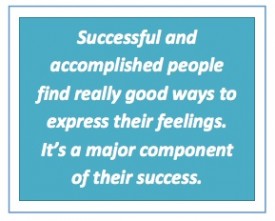From ‘teenager to grandfather’ (p. 2), this book is for every man who wants to be successful in all aspects of life, be it family, relationships or career. It is a guide for men to ‘learn a skill and develop a process’ to manage their feelings and emotions, something that most men never get to practice in their lives.
In his light-hearted, heartfelt and down-to-earth style, David Kundtz gently but firmly guides men to understand and learn how to address, accept and integrate feelings into their daily lives.
Kundtz, who holds degrees in psychology and theology, was an editor and pastor for almost twenty years before he became a licensed family therapist and director of a service specializing in stress management for helping professions.
The Man On The Moon & The Man In The Moon
Kundtz uses an interesting analogy of how men need to be both the man on and in the moon.
The man on the moon represents the “thinking guy” of logic and calculations, interested in external things and has determination.
The man in the moon symbolises the spontaneous, unpredictable man, full of life, play and understanding, who delves into the deep inner life of possibilities and experiences feelings fully.
 For men who often wonder what’s going on, and why things don’t work out better for them, Kundtz points out,it’s quite likely because they’re playing the game of life with ‘half the team’ (their feelings) missing. To be one without being the other is to be only half a person, living only half a life.
For men who often wonder what’s going on, and why things don’t work out better for them, Kundtz points out,it’s quite likely because they’re playing the game of life with ‘half the team’ (their feelings) missing. To be one without being the other is to be only half a person, living only half a life.
Kundtz makes it clear, though many relevant case studies from his own family therapy practice, that feelings have a very powerful influence on a person’s quality of life. If one is good at the feeling part of life, one’s chances of success and happiness are hugely increased.
There’s a simple quiz readers can take on page 17 to gauge their Emotional Literacy, that is, their relationship to feelings.
Damage and Differences
When men fail to acknowledge and express their feelings for example anger, hurt or grief healthily, they do damage to themselves. This is often manifested in addiction, physical or mental illness.
 Men also differ from women in that they experience “flooding” or a state of being overwhelmed by feelings, much faster than women. Thus, men often stonewall and withdraw when faced with strong emotions displayed by their female counterparts, partners, or spouses.
Men also differ from women in that they experience “flooding” or a state of being overwhelmed by feelings, much faster than women. Thus, men often stonewall and withdraw when faced with strong emotions displayed by their female counterparts, partners, or spouses.
Kundzt urges men to recognize that in daily life, it is not about separating their and feeling but integrating them. Instead of denying, burying or running away from a feeling, he points out that men need to just stay in the moment, be aware of it, acknowledge it and allow themselves to feel the emotion, even if it is sadness, anger or loneliness.
Three Steps to Emotional Fitness
Core to this book is Kundzt’s practical guide on how men can deal with their feelings:
First: Notice the feeling. Stay with it.
Second: Name the feeling. Pick a name to identify what you feel.
Third: Express the feeling. Get the feeling outside of you.
 Often for men, the first sign of the of a feeling is a change in their bodies, for instance tightening in the stomach or racing of the heart. Noticing their bodily changes is a good way to start to notice their emotional changes.
Often for men, the first sign of the of a feeling is a change in their bodies, for instance tightening in the stomach or racing of the heart. Noticing their bodily changes is a good way to start to notice their emotional changes.
Developing the habit of Stillpoints – doing nothing, on purpose, to calm down, slow down, and notice what is going on in you – is a good way for men to develop their capacity to notice their feelings. This noticing or Stillpoint to ask themselves: “What am I feeling right now? What’s going on in me?”
The next step after awareness is naming the feeling. Kundzt states that naming the feeling gives men power over it. This process enables men to establish a relationship with a part of themselves and to grow in self-knowledge. By naming it, men accept ownership of their feeling.
The third step – expressing the feeling- means externalizing feeling to get it out of the internal world into the external world. Kundzt calls this ‘getting what’s inside outside’.
Men need to choose a mode of expression that meets the goal of effectively expressing their feelings in a way that does not violate their personal value system, or do damage to themselves or others.
 Kundzt lists down a myriad of ways like telling, writing, wailing, yelling, physical acts like jumping or dancing and states that almost anything a man does, can be the expression or externalization of a feeling. However, to do Step 3 effectively, the previous two steps of Noticing and Naming have to be done first. Kundzt also gives specific attention to dealing with and expressing anger on pages 118-119.
Kundzt lists down a myriad of ways like telling, writing, wailing, yelling, physical acts like jumping or dancing and states that almost anything a man does, can be the expression or externalization of a feeling. However, to do Step 3 effectively, the previous two steps of Noticing and Naming have to be done first. Kundzt also gives specific attention to dealing with and expressing anger on pages 118-119.
The more a man is able to incorporate the Three Steps to Emotional Fitness into his life, the more he will become what he is always meant to be: both the adventurous and daring man on the moon, as well as the sensitive and lovable man in the moon.
Nothing’s Wrong. A Man’s Guide to Managing His Feelings. is available at Singapore’s Public Libraries. By building a life balanced with both thinking and feeling, men can cease living just half-a-life or being just half-a-person and instead live a more whole and fulfilling life!
Reference:
Kundtz, D. (2004). Nothing’s Wrong. A Man’s Guide to Managing His Feelings. Canada: Conari Press.
About the Author: The Dads for Life Resource Team comprises local content writers and experts, including psychologists, counsellors, educators and social service professionals, dedicated to developing useful resources for dads.

